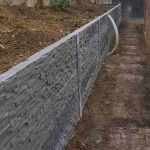Introduction
Building a retaining wall is more than simply stacking stones or putting wood; it's an art that blends engineering concepts, style visual appeals, and practical performance. As we delve into From Principle to Completion: A Day in the Life of a Retaining Wall Builder, you'll find the complexities associated with this interesting occupation. Whether it's dealing with concrete sleepers, H beams, or timber sleepers, every aspect plays an essential function in making sure that the structure not only looks good but likewise stands the test of time.
What is a Retaining Wall?
A maintaining wall is a structure developed to hold back soil and avoid erosion on sloped surfaces. These walls are essential for keeping landscape stability and can be made from different materials such as stone, wood, and concrete.
The Function of a Retaining Wall Installer
A retaining wall installer is responsible for changing strategies into concrete structures. They work closely with designers and landscape designers to guarantee that the completed item fulfills both functional and visual criteria.
Understanding the Different Types of Keeping Walls
Concrete Sleepers
Concrete sleepers are pre-cast blocks used for their effectiveness and http://garretttaiu792.lucialpiazzale.com/finding-inspiration-creative-solutions-from-innovative-retaining-wall-installers toughness. They offer exceptional assistance for heavy loads and are resistant to rot and pest damage.
H Beams
H beams offer significant structural support due to their shape, making them ideal for taller maintaining walls where extra strength is required.
Wood Sleepers
Though aesthetically attractive, wood sleepers need regular maintenance due to their susceptibility to decay. Nevertheless, they can offer a warm visual that mixes well with natural landscapes.
Timber Sleepers
Timber sleepers are frequently utilized in domestic jobs where less height is required. They can develop a rustic appeal but included issues about longevity.
Stone Keeping Walls
Stone walls are timeless and can add enormous value to homes. Their natural look makes them popular in landscaping designs however requires skilled workmanship for appropriate installation.
The Preliminary Assessment: What Happens First?
During the preliminary consultation phase, a retaining wall contractor meets with clients to discuss their needs and preferences. This phase includes website assessments, understanding drain problems, and determining material choices.
Planning & Design Stage: Crafting the Blueprint
Once initial conversations conclude, detailed blueprints are produced. This plan consists of measurements, material specifications (be it concrete sleeper or stone), and drainage solutions.
Permits & Regulations: Browsing Legalities
Before construction begins, protecting necessary permits is important. Building regulations vary by location; for this reason comprehending regional regulations guarantees compliance throughout the project.
Preparing the Site: Cleaning & Excavation Work
Preparing the website involves cleaning vegetation and particles followed by excavation work. This step lays the foundation for a structurally sound maintaining wall.
Material Selection: Picking The Right Components
Selecting materials lines up closely with design goals while likewise thinking about budget restrictions. Elements like resilience (concrete vs. timber sleeper) play a necessary role in this decision-making process.
Foundation Work: The Significance of Stability
A solid foundation is non-negotiable when developing any keeping wall. Whether utilizing H beams or stone, ensuring stability avoids future collapses or shifts.
Construction Process: Detailed Execution
Lay Out The Plan
Utilizing stakes and string lines helps imagine where each component will go.
Excavate For The Base
Digging down makes sure that water will drain effectively far from the wall.
Install Drain Solutions
Appropriate drain systems avoid soil saturation behind walls.
Constructing The Wall
Depending upon picked products (like concrete sleepers), walls might be constructed layer by layer.
Backfilling
As soon as installed, backfilling assists stabilize the structure while making sure sufficient drainage.
Finish Work
Adding any desired features like caps or decorative components finishes the look.
Tools of The Trade: Important Equipment For Builders
Having a range of tools at hand makes all tasks simpler:

- Shovels & & Picks Levels Compactors Trowels Power Tools
Quality Control Measures During Construction
Quality control guarantees that every element meets market standards:
- Regular Inspections Material Testing Adherence To Plans
Addressing Difficulties On-Site: Problem-Solving Skills Required
No construction task goes off without a hitch! From unanticipated weather changes to material shortages-- being versatile is key!
Final Touches: Aesthetic Enhancements For Your Maintaining Wall
After construction comes beautification:
Landscaping around it Adding plants or lighting Painting or staining wood structuresMaintenance Tips For Durability Of Retaining Walls
To extend the life of your keeping wall:

- Regularly inspect for cracks Clean particles Check drain systems
Common Frequently asked questions About Maintaining Walls
1. What materials are best for constructing retaining walls?
Choosing between concrete sleeper, stone, timber sleeper depends on aesthetic preference and structural requirements.
2. How tall can my maintaining wall be?
Local guidelines dictate height limitations; typically between 4-- 6 feet without unique permits.
3. Do I require planning permission?
In most cases yes; check regional building codes before beginning construction.
4. Can I set up a maintaining wall myself?
While do it yourself is possible, hiring professionals makes sure safety and compliance with regulations.
5. How do I preserve my retaining wall?
Regular assessments must focus on checking for fractures or drain issues; immediate repair work enhance longevity!
6. Are retaining walls expensive?
Costs vary based upon materials picked(e.g., wood vs stone)together with labor costs involved.
Conclusion
In conclusion, building a keeping wall involves precise preparation from start to complete-- hence why understanding every step in this journey from principle through completion matters immensely! From picking products like concrete sleepers or wood to browsing legal requirements-- it's clear how detailed this process really is! So next time you see one standing tall versus nature's forces-- take a minute to value all that went into producing it!